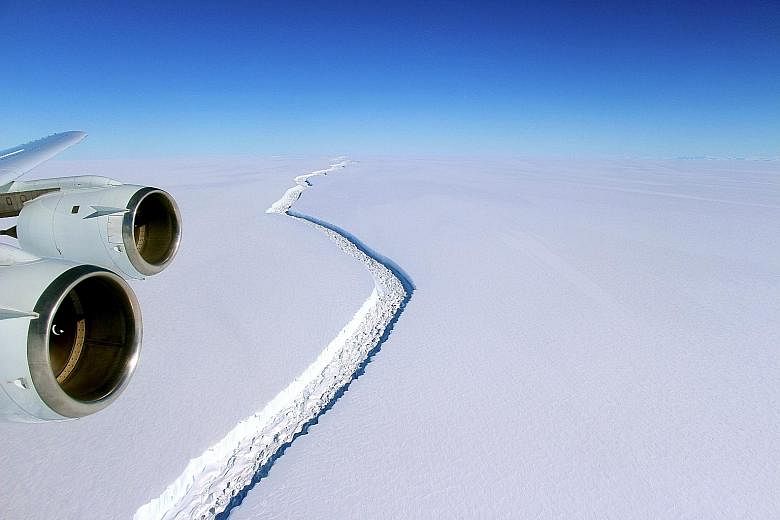LONDON • An enormous rift in one of Antarctica's largest ice shelves grew dramatically over the past several weeks, and a chunk about seven times the size of Singapore could break away within months, British scientists have reported.
The rift in the Larsen C ice shelf suddenly grew by 18km at the end of last month, leaving the finger-shaped chunk - 350m thick - connected along only a small fraction of its length. The rift has also widened, from less than 50m in 2011 to nearly 500m today.
"If it doesn't go in the next few months, I'll be amazed," said Dr Adrian Luckman, a professor at Swansea University in Wales and leader of Britain's Project Midas, which tracks changes in West Antarctic ice formations.
By itself, the soon-to-be iceberg, which would be about 5,000 sq km in size, will not add to sea levels.
This is because the vast Larsen C ice shelf is already floating on the sea - like an ice cube floating in a glass of water.
What is worrying scientists is the consequences of ice-shelf disintegration in Antarctica.
Ice shelves hold back huge amounts of ice from inland glaciers.
If the huge iceberg does break off, it could accelerate a further break-up of the Larsen C ice shelf, essentially removing a massive cork of ice that keeps some of Antarctica's glaciers from flowing into the ocean.
The long-term result, scientists project, could be to noticeably raise global sea levels by 10cm.
It is the latest sign of major ice loss in the fast-warming Antarctic Peninsula, which has already seen the break-up of two other ice shelves in the same region. These events have been widely attributed to climate change.
"When it calves, the Larsen C ice shelf will lose more than 10 per cent of its area to leave the ice front at its most retreated position ever recorded; this event will fundamentally change the landscape of the Antarctic Peninsula," said the researchers in a statement about the rift.
"We have previously shown that the new configuration will be less stable than it was prior to the rift, and that Larsen C may eventually follow the example of its neighbour Larsen B, which disintegrated in 2002, following a similar rift-induced calving event," the researchers said.
The Antarctic continent is ringed with ice shelves, which are the ocean-front portions of larger glaciers. But as the climate changes, these features have been thinning, and, in some cases, breaking apart dramatically.
Previous research has also documented that the Larsen C ice shelf is becoming less thick, and so floating lower in the water. This appears tied to the warming of the Antarctic Peninsula in recent decades. Warmer seas could also be playing a role.
WASHINGTON POST, AGENCE FRANCE-PRESSE

